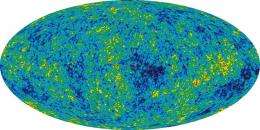Ripples in the cosmic background

(PhysOrg.com) -- The universe was created 13.73 billion years ago in a blaze of light -- the big bang. We also think that, about 380,000 years later, after matter (mostly hydrogen atoms) had cooled enough for neutral atoms to form, light was able to travel through space relatively freely. We see that light today as the cosmic microwave background radiation (CMBR). The light appears extremely uniform in brightness across the sky. Astronomers have discovered, however, that the radiation has very faint ripples and bumps in it, at a level of only about one part in one hundred thousand.
These ripples reflect the architecture of the universe when the light was freed, and the subsequent cosmic structures (galaxies and clusters of galaxies) as the light passed by them on its journey through space and time. These ripples hold clues, therefore, to the early universe and how it has evolved, and are consequently among the top priorities of modern astronomy research.
The wavelengths of the CMBR ripples span a continuous range of sizes. The larger ones (which are also brighter) are the result of the waves in the cosmic structure when the light was released; the universe has stretched in size so much since then (a factor of about 1000) that they are now comparatively big. The smaller ones imposed on the light later, as it was scattered by galaxy clusters or other objects, are shorter and dimmer. Over the past few decades astronomers have been able to measure the larger ripples with great accuracy, and to use that information to substantiate and refine many details of the big bang scenario. The smaller bumps have been harder to pin down.
Writing in this month's Astrophysical Journal, a large team of scientists including SAO astronomers Brian Stalder and Tony Stark report the successful measurement of CMBR ripples using the the South Pole Telescope, a ten-meter-diameter submillimeter telescope located at the Amundsen-Scott South Pole station in Antarctica.
The team was able to make the first significant measurements of the weakest, shortest wavelength ripples yet studied. They discovered that the amplitude of the fluctuations is only about half that previously measured (or indicated by other related, previously measured parameters) -- a significant deviation. Moreover, their uncertainties of 35% are the smallest yet, yielding further refinements to big bang models. The results imply that although the formation of the first galaxies is still poorly understood, continuing improvements to the observations are rapidly enabling astronomers to zero in on these basic puzzles of cosmic origins.
Provided by Harvard-Smithsonian Center for Astrophysics

















